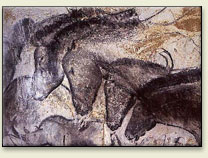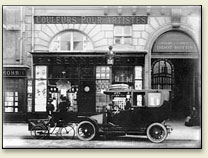| For millennia, humans have beautified their world and expressed their thoughts by painting. Over the years, paintings have been made on virtually every imaginable surface. The common characteristic is that paint consists of ground up pigment in some sort of liquid. When the liquid dries into a film, the ground pigment is stuck to the painting surface. The first paintings were cave paintings, such as those pictured at right. Ancient peoples would decorate walls of protected caves with paint made from dirt or charcoal mixed with spit or animal fat. In cave paintings, the pigments (often carbon black or ochre) stick to the wall partially because the pigment gets trapped in the porous wall, and partially because the binding media (the spit or fat) dries, adhering the pigment to the wall. Over the years, countless graves unearthed by archaeologists exposed bodies covered in red pigment or chunks of pigment buried alongside bodies. Red, associated with blood, the most life-sustaining of a bodily fluids. was the appropriate color to symbolize life's meaning and end. The word hematite (the source of many iron oxide pigments) is derived from the Greek word, hema meaning blood. Prehistory Prehistoric dwellers may have discovered that unlike the dye colors derived from animal and vegetable sources, the color that came from iron oxide deposits in the earth would not fade with the changing environment. For this reason, it is estimated that men traveled long and far to maintain a steady supply of red pigment. In every locality where prehistoric sites were discovered, from Texas to South Africa, trails lead to near and far hematite deposits where man mined. It has even been deduced that the impetus behind all mining activities was sparked by prehistoric man's need for red pigment. Combining their expertise, art historians and conservators used examination, chemical analysis and ethnographical (cross-cultural) comparison to hypothetically reconstruct the artistic materials and techniques of the cave dweller. It is assumed that all the colors used by Paleolithic artists have a foundation of mineral oxide (either iron or manganese) or carbon. Their limited palette was produced from three basic colors: red, black and yellow. Reds, yellows, and browns came from the limonites and hematites (ochres and siennas), where a range from reddish brown to straw color is evident in the paintings. Shades of red-violet and mauve were perhaps the product of natural peroxide of iron transformed slowly and naturally into violet oxide. Blacks were derived from manganese ores and charcoal. Excavations in the Lascaux area prompted speculation that cave dwellers traveled as far as 25 miles to obtain ion oxide pigments The oxides of iron dug right out of the ground in the form of lumps were presumably rich in clay. This consistency was conducive to the formation of crayon sticks and also could be made into a liquid paste more closely resembling paint. It is believed the lumps were ground into a fine powder on the cave's natural stone hollows where stains were observed. Shoulder and other bones of large animals, stained with color, were discovered in the caves and presumed to be used as mortars for pigment grinding. The pigment was made into a paste with various binders, including water, vegetable juices, urine, animal fat, bone marrow, blood and albumen. Historians hypothesize that paint was applied by brushing, smearing, dabbing and spraying techniques. Large areas were covered with fingertips or pads of lichen or moss. Twigs produced drawn or linear marks, while feathers blended areas of color. Brushes made from horse hair were used for paint application and outlining. Paint spraying, accomplished by blowing paint through hollow bones, yielded a finely grained distribution of pigment, like airbrush. Iron oxide pigments constituted the basic palette of ancient artisans, from Egypt to India and China. The Minoans, attributed with inventing the fresco, mixed their pigments with water and applied them to a fresh lime surface. The technique, called buon fresco, requires pigments that bond permanently to lime. Iron oxide pigments, unaffected by alkalies, remain the basic palette of fresco painters, from the Minoans to the present. |
|
Friday, April 3, 2009
EARLY PIGMENTS
Subscribe to:
Post Comments (Atom)


No comments:
Post a Comment